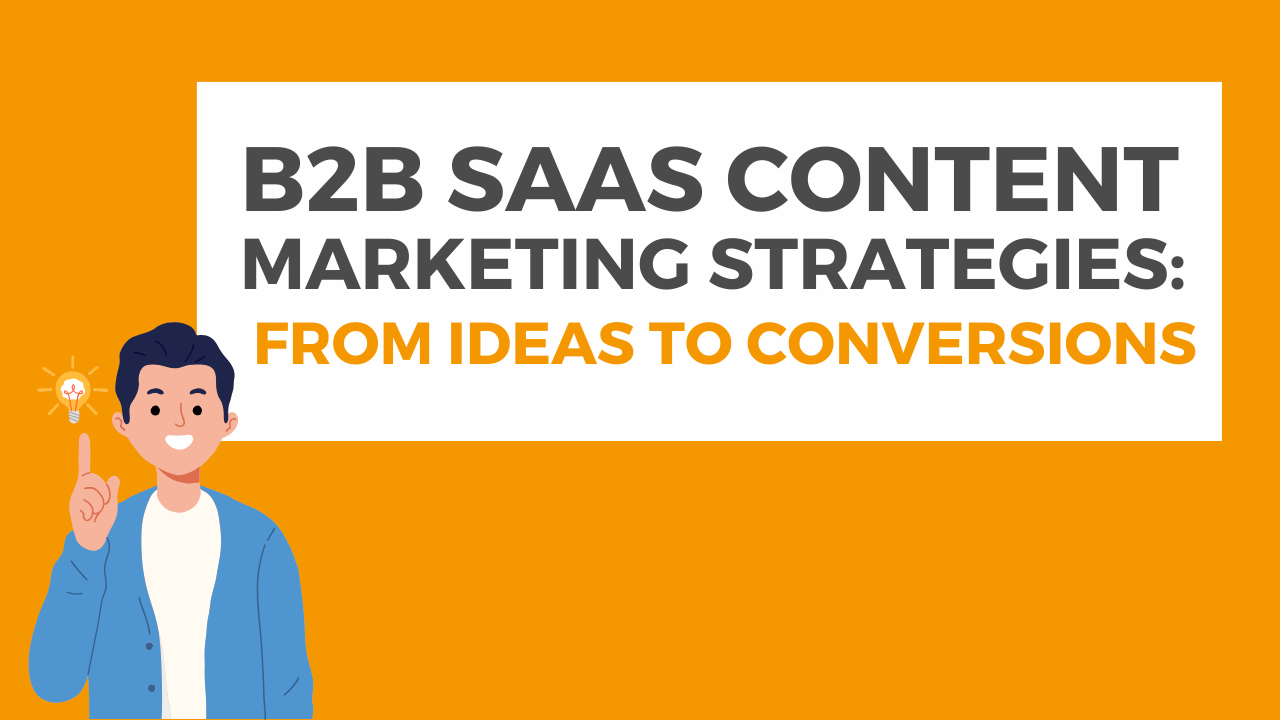Which content marketing medium is right for you? Where should your ideas come from? And how do you build a SaaS content strategy that converts? Here’s our guide.
Related Articles:
7 B2B SaaS Digital Marketing Strategies To Achieve Success
5 SEO Marketing Strategies for B2B SaaS Companies
Mastering SaaS PPC Advertising: Proven Marketing Strategies
Scaling Success: Marketing Automation Tactics for SaaS Companies
Maximising Reach: 7 Effective SaaS Social Media Strategies
Mastering B2B SaaS Lead Generation: 7 Strategies That Work
Which SaaS content marketing strategy?
If you’ve dipped into our posts previously, you’ll know that content is the bedrock of any SaaS inbound marketing campaign. Google loves it. People need, value or want it. And when we’re talking about SaaS products, which invariably require a significant amount of explanation, content becomes even more important.
Content marketing informs. It advises and persuades. It helps build relationships and then keeps those relationships ticking along (as long as you keep creating content). It drives leads and, although an admittedly slow-burn approach, it tends to significantly outperform more in-your-face marketing methods.
In this article, we’re going to focus on blog posts, because blog posts are arguably the easiest, most cost effective and most adaptable form of content marketing to produce unless you happen to have a recording studio handy or you’re a dab hand at video editing. They are, however, not the only option:
Videos
The particular power of video as a content marketing vehicle for your SaaS product is that you’re able to (literally) show, not tell. Ideal for ‘how to’ explainer content, a series of short videos can act as a user guide for your product, helping to showcase ease of use ahead of purchase, while remaining valuable as an instruction manual post purchase.
Podcasts
Everyone’s doing a podcast. The market is saturated. There are too many, too similar podcasts aiming to attract too few listeners for podcasters to make money. Forbes said all of that in 2020 and the podcast market has grown even more since then.
But the point of producing a podcast built around the service your software supports isn’t to make you a player in the world of podcasting. You’re not aiming to outdo The News Agents, Joe Rogan or the Off Menu chaps. You don’t need your podcast to attract advertisers and make money (although if that happens, all well and good).
The point of podcasting as a content marketing tool for SaaS businesses is to talk about the industry and the challenges your prospective customers face, and to build your own profile and credibility as an industry leader by talking to others in the sector.
You’re unlikely to amass millions of listeners, but as a calling card to potential customers and a way to build an ongoing relationship with them, it can be an extremely powerful, personal tool.
White papers, reports, infographics and e-books
In the section that immediately follows this one, I wanted to share some stats about blog readership. Thankfully, HubSpot came to my rescue with data that has helped me make my case.
That neatly illustrates the value of producing your own data on your part of the SaaS sector. Because when anyone else is writing about it, they’ll want evidence to back up their position. If that data comes from you, you’ll be able to build your reputation not just from publishing your own content about the research and insights you’ve uncovered, but from everyone else who piggy-backs on your effort.
Is the blog dead?
No. Far from it. There has, however, been a fairly bewildering surge in posts asking that question recently.
According to HubSpot’s State of Marketing report, “blogs are among the top marketing channels that offer the highest ROI”. And according to this survey by HubSpot, more people read blog posts every day than never read them at all.
So how come so many people have been claiming their demise?
There is a part of the blogging world that does appear to be petering out. The individual blog post written to share personal thoughts — the blog written for entertainment — is all but extinct.
But blogging for business is as robust as it ever was. A few years ago, a bunch of content marketers were asked what they would do differently if they were starting from scratch. A whopping 50% of them said they would focus more on blogs.
Crucially for SaaS businesses, 71% of B2B buyers say blog content plays a role in their buying journey.
That’s not to say everyone will digest every word you write, but a majority of blog readers either read deeply or apply an even mix of deep reading and skimming. Only 6% cut to the chase, look only for the information they came for, and then leave again.
Blogs are sticky. So how do you ensure your readers stick? That all starts with choosing the right topics, but how do you know what those topics are?
Where content marketing ideas come from
A great blog topic (or podcast discussion point) is one that touches on hot button issues. If it’s something people are talking about within your world, it’s a good bet people will want to find out more about it. Here’s how to build your feed of inspiration:
- Subscribe to other podcasts and blogs, not so you can plagiarise their material (something that will appeal to neither Google nor your readers) but so you can use them as launch points for your own take on the topics raised
- Talk to your existing customers to explore the issues that matter to them
- Set up Google alerts so you never miss out on news relating to the SaaS topics that matter
- Carry out your own research. Yes, it’s a potentially time consuming and relatively costly option, but a single piece of research can feed multiple pieces of content and, crucially, it will be entirely original, useful and can be bundled up not only as blog posts, but in reports, videos and podcasts too.
How to build a SaaS content marketing strategy that converts
1. Write for every stage of the funnel
One of the most common pitfalls for SaaS companies is the tendency either to focus on ‘how to’ content (which assumes someone who engages with your content has already bought your product), or high-level material designed to inspire a deeper dive into something more in-depth.
Both may be important, but so are all the points in between. Your content marketing needs to support each stage of the traditional marketing funnel, so ensure you’re creating for top, middle and bottom-of-funnel to turn readers into qualified leads.
How do you do that? A simple trick is to apply the ‘OK, so now what?’ test. Once a reader reaches the end of your content, where should they look next to dig deeper? Ideally, there should always be material that you can link to (your own material, that is) that helps take them closer to the point at which they buy.
2. Look beyond problem/solution
There’s nothing inherently wrong with the problem/solution approach, but it can be a self-limiting tactic. Content marketing is a long-term commitment. Ideally, you’ll still want to be posting content months or even years from now and there are only so many problems to address, so take a wider view to give your content legs (see below).
3. Focus on people not products
We looked earlier at the potential of video to act as a brilliant medium for providing ‘how to’ content, because you can put your SaaS product on screen and show every tap and click required to perform a certain task. Such content is entirely product related and it’s clearly not top of funnel stuff, by which we mean this isn’t content that will hook someone entirely new to the conversation.
Blog and podcast content, however, come from a different perspective. Make it about users, the challenges they face, the goals they have, the jobs they’re trying to complete and the world in which they operate, and you create top and mid-funnel content that engages because it’s not about a product; it’s about them.
4. Add evidence that supports your credibility
You may not have primary evidence to support the position you’re taking in your post. You may, therefore, be forced to quote others in the industry who do. That’s fine.
But where you do have your own data, from a customer survey, consumer research or similar, be sure to use it and link to it.
5. Sell your SaaS product as one way to address the issues you raise…
… not the only way to address the issues you raise. Blogs treat selling with a light touch. Go too heavy and you’ll undermine the authenticity of the content that surrounds it and potentially stop the reader from dipping into your content again in the future.
To sell subtly, position your product as one of a range of viable options, or bring the post back to your personal experience and the story/values/mission of your organisation, like this:
“When we were developing our SaaS product, we figured that the best way to address X was by Y. That’s why we created Z.”
6. Think about delivery as well as content creation
The best blog post in the world won’t make an impact unless you have a strategy to ensure people see it. You might do that via your social channels. Perhaps you’ll do it via email. But do make sure you have a plan for ensuring that people know that your latest post/podcast/report is now available.
Who should create your content?
In an ideal world, you should. Nobody knows your topic like you do, and now that Google requires less in the way of formal keyphrases and keyword densities, it’s easier to simply write rather than having to run everything through your ‘will Google like this?’ filter.
There is, of course, a fairly hefty caveat to this. Few SaaS C-suites have the time to sit down and write a blog post every week. You could delegate responsibility to the team, but you’ll need a gatekeeper on hand to monitor quality, and there’s no guarantee that your people will feel comfortable — or are capable — of giving you 2,000 compelling, insightful and well-written words.
On the other hand, outsource the writing and you risk handing over the content to a great writer who knows nothing about your world.
One potential solution is to take a hybrid approach, where you provide information (perhaps as part of a monthly interview) and an experienced content writer turns your conversations into blog posts that carry all your knowledge and insight, but which don’t require you to sit at a keyboard for hours.
Create content marketing that converts
If you’d like to create content – or a content strategy – to take your SaaS product from ideas to conversion, we’d love to help. Talk to us now.




